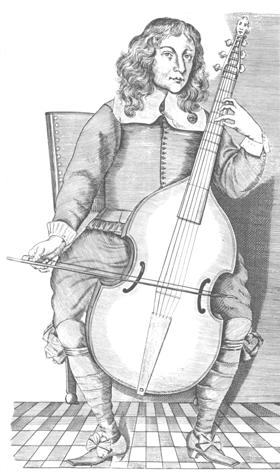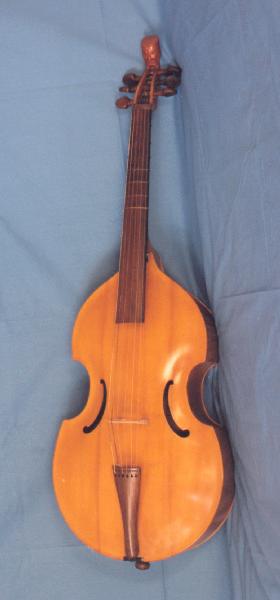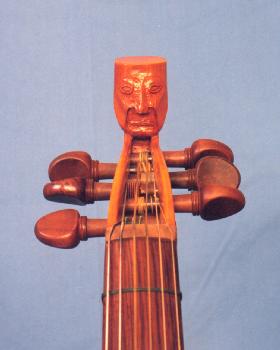The Sound of the Division Viol
A hybrid between medieval plucked guitars and bowed rebecs, the instruments now called gambas (from the Italian viola da gamba) were almost all played in French style when I was a student - meek and subservient, col parte with harpsichord as accompaniment for solo instruments. There was a German tradition based on equal consorts, with large basses and wider fingerboards, apparently played more powerfully and at a lower pitch. But, over on the island of England, another tradition flowered for a while, which they called the division viol.
There is an oft told story about a king of France meeting with a king of England: the English king called for his broadsword and smashed through a great iron bar with one blow. The French king responded by dropping a feather on his sword which was sliced in two by the keen edge. Their viols appear to have been just about as different. The English instrument was for battle in a culture where brute strength was admired. The local player and a visitor would meet in a great hall, take a theme chosen by the local, then seek to outdo each other with raw speed and power. Division meant time division - the objective was to play 2, 3, 4, 6, 8 ... (11?) acceptable notes for each note of the original theme. Musical elegance it was not!
What was different about the instruments? The most highly regarded player of the time, Christopher Simpson (The Division-Viol, 1659) described them with "the Bellyes being digged out of the Plank", but then so were all similar instruments of the time according to conventional knowledge. The division bow arm was kept absolutely rigid and straight at the elbow, with almost all movement made solely by the shoulder joint. With such an arm dynamic, the bow must be very stiff (as Simpson says it must). Such a bow technique stood in sharp distinction to European practise, and places a mass behind bow movements that crushes the sound of French instruments. In fact, French authors of the time usually assumed that descriptions of the English division bow technique were mistaken.
Then, there are the descriptions of the English volume. One manuscript I found described a typical battle between the local and a visitor. Once the local had retired from the field, the visitor let loose his full skill, and the sound of his single instrument was described as being audible in the kitchen. The foundations of the house mentioned in that manuscript were still visible when I was a postgrad student at Cambridge. The main hall was essentially a great stone cube, over 10 m to the side, and would have been full of noisy diners and scurrying servants. From one side, a hallway led under a balcony past a courtyard a full 20 m to a kitchen almost the area of the great hall. There were three huge hearths there, that would have had roaring fires cooking things like an entire ox on a spit, tended by chefs shouting orders to underlings. Standing by one of those kitchen hearths, I knew that no gamba I had ever heard could carry anywhere near so far.
What a challenge - to recreate such a sound! Well, in Cambridge, I found a young viola maker, trained at the world renowned Mittenwald school, who gave guitar-making classes at a local technical school. Juliet Beamont listened to this kid from the colonies who claimed that some stones had spoken to him, and agreed to help. So, after combing through everything I could find in the University libraries, I measured the curve of my 18th century Widhalm German violin for a top - steep and powerful. The depth (deep) and size (small) of the body came from drawings of the time, and from photos of a particularly beautiful division-sized viol at the Eszterháza, the bridge shape from drawings of the time. The pegbox head came from an Incan mug in the British Museum, and a two-teardrop shape from my eye (but very close to traditional shape).
Then, I began to learn the traditional craft of violin making: arm-length wood-bodied planes, 'scrapers' (they don't scrape, they cut, with an edge as keen as a Belgian stone can give), reverse-curve gouges, and the violinmaker's knife - as strong as an English sword but with an edge as keen as the French. The Mittenwald tradition was that the more difficult a wood is to work with, the better the sound it will give. So the table ('belly') is made from air-dried spruce from the mountains of northern Italy with winter wood as dense as ebony and summer wood as fragile as balsa. The bass bar is carved integral with the table, following several old examples. (Violin family bars must be fitted, as they are put in under tension.) The back and sides are of European maple with grain that, to paraphrase Stephen Leacock, rides madly off in all directions, the fingerboard and tailpiece from a piece of rosewood tough enough to serve for railway tracks. I learned a lot about sharpening tools that year!
The resulting sound is powerful. The dynamic is right - it gives its best with a firm weighty bow stroke close to the bridge. When rope-arm players used to French bows pick it up, they generally say "yuk" after a single bow stroke and hand it back! Yet, the sound is obviously gamba, not violoncello, especially when played in consort with itself via a tape recorder.
Well, I fell in love with the harpsichord and never did develop the skill to play gamba properly. But, the wood-judging skills I learned and the tools I collected started my son Michael on his path a generation later - he's now an internationally respected maker of guitars.
Update 2020: recent research has revealed that most British gambas of the period were not made with "Bellyes being digged out of the Plank", but rather were made of coopered construction, typically five separate relatively thin pieces that approximated the desired belly shape before final carving. And that means that Simpson preferred European instruments, which must have been modified to get the volume required by division gamba players. Soundpost addition/adjustment would do some of it, a stronger bridge and heavier strings could do some more, and higher pitch could add power as well as resistance to stronger bowing. So, the whole basis of my approach was wrong.
However, my skill and love of woodworking has stayed with me all my life, and has been passed on to my son. True learning is seldom wasted.

Christopher Simpson, 1659

the division viol, 3 centuries later

detail of the pegbox